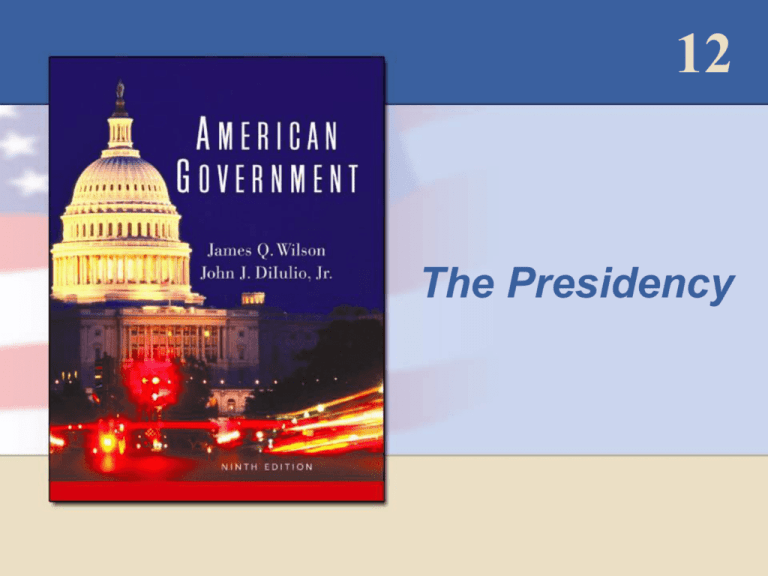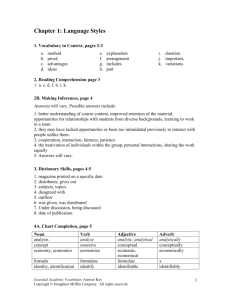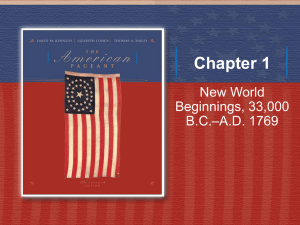
12
The Presidency
Presidential Power
• Prime Ministerial Power
• Party leader, selects cabinet officers. Cabinet
officers must support policy or resign. Minister in
charge of failed policy must resign (WMD)
• Presidential Power- Much weaker
•
•
•
•
Nominated by non-party officials.
Little experience in DC, Cabinet as “spoils”
President and Congress were meant to share power
Few Powerful Presidents, JQ Adams-FDR:
– Jackson, Polk, Cleveland, Lincoln
• New Powers, supported by Supreme Court:
– Independent offensive military capabilities
– Domestic policy initiatives- internment, air traffic control
– Neustadt: Power ultimately from PERSUASION
2
Figure 12.2: Presidential Popularity
Source: Thomas E. Cronin, The State of the Presidency (Boston: Little, Brown, 1975), 110-111. Copyright 1975 by Little, Brown and
Co., Inc. Reprinted by permission. Updated with Gallup poll data, 1976-1993. Reprinted by permission of the Gallup Poll News
Service.
Copyright © Houghton Mifflin Company. All rights reserved.
12 - 3
Figure 12.2: Presidential Popularity (cont’d)
Source: Thomas E. Cronin, The State of the Presidency (Boston: Little, Brown, 1975), 110-111. Copyright 1975 by Little, Brown and
Co., Inc. Reprinted by permission. Updated with Gallup poll data, 1976-1993. Reprinted by permission of the Gallup Poll News
Service.
Copyright © Houghton Mifflin Company. All rights reserved.
12 - 4
Table 12.3:
Partisan Gains
or Losses in
Congress in
Presidential
Election Years
Copyright © Houghton Mifflin Company. All rights reserved.
12 - 5
Table 12.4:
Partisan Gains
or Losses in
Congress in
Off-Year
Elections
Copyright © Houghton Mifflin Company. All rights reserved.
12 - 6
Table 12.5: Presidential Vetoes, 1789-2000
Copyright © Houghton Mifflin Company. All rights reserved.
12 - 7
Presidential Institutionalization I
• Necessities of a vast Bureaucracy
• Brownlow Commission, 1937: Pres. needs help
• White House Office and Executive Office of
President created; staffed near 400 people
• Three Organizational Strategies
• Pyramid (Eisenhower, Nixon, Reagan, Bush I/II
• Circular (Carter early in administration)
• Ad Hoc (Clinton early in administration)
• EOP: includes WHO and OVP
• Agencies mandated by law; Senate confirms
• Office of Management and Budget, National S.C.
• Cabinet: Little, expandable fiefdoms
• Few nominatable positions
8
Pres. Institutionalization II
• Three Persuasive Audiences
– Fellow Politicians in DC
– Party Activists and Officeholders outside DC
– The Public
• Three Policy Prerogatives
– The Veto
• Only 4% overrident
• Line-item veto struck down
– Executive Privilege (controversial)
• US v. Nixon (1971), Cheney’s “energy” policies
– Impoundment: Budget Reform Act of 1974
– President has short window to act
9
Figure 12.1: Growth of the White House Office,
1935-1985
Sources: For 1935-1977: Congressional Record (April 13, 1978), 10111; for 1979-1985: annual reports filed by the White House with
the House of Representatives Committee on Post Office and Civil Service, titled "Aggregate Report on Personnel; Pursuant to Title 3,
United States Code, Section 113"; and Budget of the United States Government. From Samuel Kernell and Samuel Popkin, eds.,
Chief of Staff (Berkeley: University of California Press, 1986), 201.
Copyright © Houghton Mifflin Company. All rights reserved.
12 - 10
•
•
•
•
•
Presidential Succession
Key problem: legitimacy
FDR: only 4-termer
8 VP’s have ascended
25th Amendment provides for succession
Impeachment: an Indictment only
– Senate must convict
• Andrew Johnson: missed removal by one vote
• Nixon: resigned to avoid impeachment; removal?
• Clinton: impeached but not removed (2/3 required)
11
Map 12.1: Electoral Votes per State
Copyright © Houghton Mifflin Company. All rights reserved.
12 - 12
Table 12.1: The
Cabinet
Departments
Copyright © Houghton Mifflin Company. All rights reserved.
12 - 13
Table 12.2:
Number of
Political
Appointments
in Cabinet
Departments
Copyright © Houghton Mifflin Company. All rights reserved.
12 - 14


